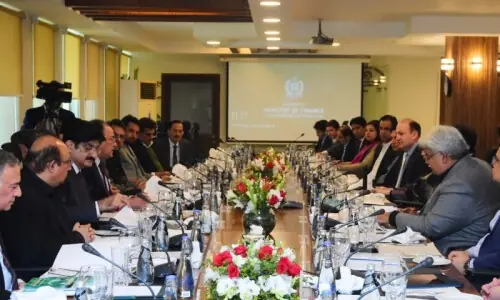WASHINGTON, May 9: Pakistan is preparing its next-generation of nuclear-capable ballistic missile for deployment, says a report by the Federation of American Scientists. The federation was founded 60 years ago by scientists who worked on the Manhattan Project to develop the first atomic bombs.
The report acknowledges that “the main driver for Pakistan's nuclear modernization appears to be India's nuclear build-up, although national prestige probably also is a factor.”
The two countries appear to be entering a new phase in their regional nuclear arms race with medium-range ballistic missiles gradually replacing aircraft as the backbone of their nuclear strike forces, the report adds.
But it warns that in contrast to aircraft, ballistic missiles have a very short flight time and cannot be recalled once launched.
The FAS report on Pakistan includes a satellite image taken on June 5, 2005, which, the authors say, shows a 15 Transporter Erector Launchers (TEL) for the medium-range Shaheen 2 fitting out at the National Defence Complex near Fatehjang, approximately 30 km southwest of Islamabad.
The authors say that they discovered the vehicles while preparing for the latest nuclear notebook on Pakistani nuclear forces published in the May/June issue of the Bulletin of the Atomic Scientists. The notebook is written by Hans M. Kristensen of the Federation of American Scientists and Robert S. Norris of the Natural Resources Defence Council.
The authors estimate that Pakistan currently has an arsenal of about 60 nuclear weapons. In the last five and a half years, Pakistan has deployed two new nuclear-capable ballistic missiles, entered the final development stages of a potentially nuclear-capable cruise missile, started construction of a new plutonium production reactor, and is close to completing a second chemical separation facility.
As Pakistan completes development of two more nuclear-cable ballistic missiles and a cruise missile in the next few years, the nuclear arsenal will increase further.
According to the report, Pakistan established the National Defence Complex in 1993, which has since expanded into a centre for the development of the country's missile force. The main facilities are spread over a 6x2 km (4x1 mile) area on a ridge, and include what appear to be administrative buildings, missile assembly halls and garages. At two locations, several large six-axle vehicles are clearly visible on the satellite image, as are several smaller four-axle vehicles.
Approximately 1.5 km (0.9 miles) northwest from the main building is a cluster of what appears to be five recently-constructed garages. Parked in front or partially inside the two largest garages to the west are 11 vehicles that, the authors claim, show the characteristic six-axle design of the Shaheen 2 TEL, indicating that the launcher itself has not yet been installed.
The second facility is located just south of the main building and includes what may be four large assembly halls where, the authors claim, the missile launchers are installed on the vehicles. One six-axle vehicle appears to be about to enter the hall. Outside the other end of the building are what appear to be two Shaheen 2 TELs that have completed instalment of their missile launcher, thereby obscuring the axles of the vehicles. Two four-axle vehicles are also visible, which, the authors identify as Shaheen 1 TELs awaiting assembly.
The authors say that the image is good enough to determine that the large vehicles strongly resemble the six-axle Shaheen 2 TELs photographed at Pakistan Day parades. Each six-wheel vehicle is 16-17 meters long with a drivers’ compartment that covers the front axle.
Although the Shaheen 2 launchers appear to be fitting out at the National Defence Complex, the authors of the report say that the missile they are intended to carry is not yet through to be fully operational. Three test-launches of the 2,000+ km missile have been conducted since 2004, the most recent in May 2006, and a couple more are probably needed before the missile can be deployed.
Once Shaheen 2 does become operational, it will give Pakistan the ability to target facilities across most if not all of India and hold all of India's major cities at risk. As such Shaheen 2 will be Pakistan's response to India's long-awaited deployment of the Agni II missile, the authors conclude.


































